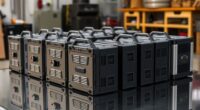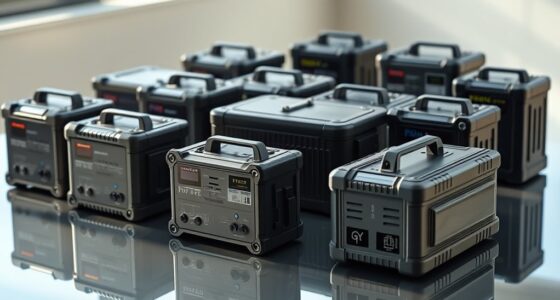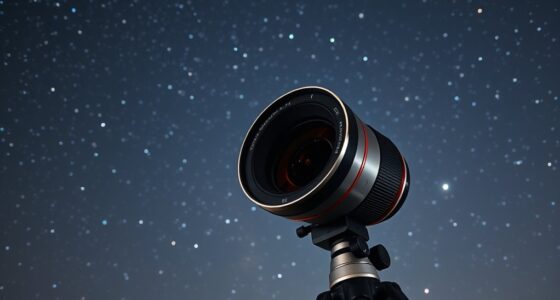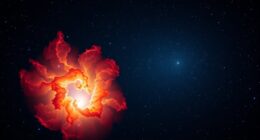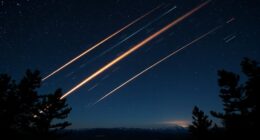If you’re looking for the best APS-C CMOS astro cameras in 2025, I recommend considering models like the ZWO ASI2600MM-Pro for monochrome imaging, the ZWO ASI183MC Pro for high-resolution color shots, and the SVBONY SV605MC for cooled, low-noise deep-sky photos. Other great options include the SVBONY SV405CC and ZWO ASI174MM-MINI, offering a variety of resolutions and features. Keep exploring further, and you’ll discover the perfect camera to elevate your stellar photography.
Key Takeaways
- APS-C CMOS astro cameras like ZWO ASI2600MM-Pro and ZWO ASI183MC Pro offer high resolution and low noise for detailed stellar imaging.
- Cooling capabilities, such as TEC cooling to -45°C, are essential for reducing thermal noise during long exposures.
- High frame rates and fast data transfer (USB 3.0/USB-C) enable real-time viewing and high-quality planetary and deep-sky captures.
- Compatibility with various software and adapters ensures flexible integration with different telescopes and imaging setups.
- The latest models in 2025 emphasize advanced features like high dynamic range, high sensitivity, and durability for professional-grade astrophotography.
ZWO ASI2600MM-Pro Monochrome Astronomy Camera
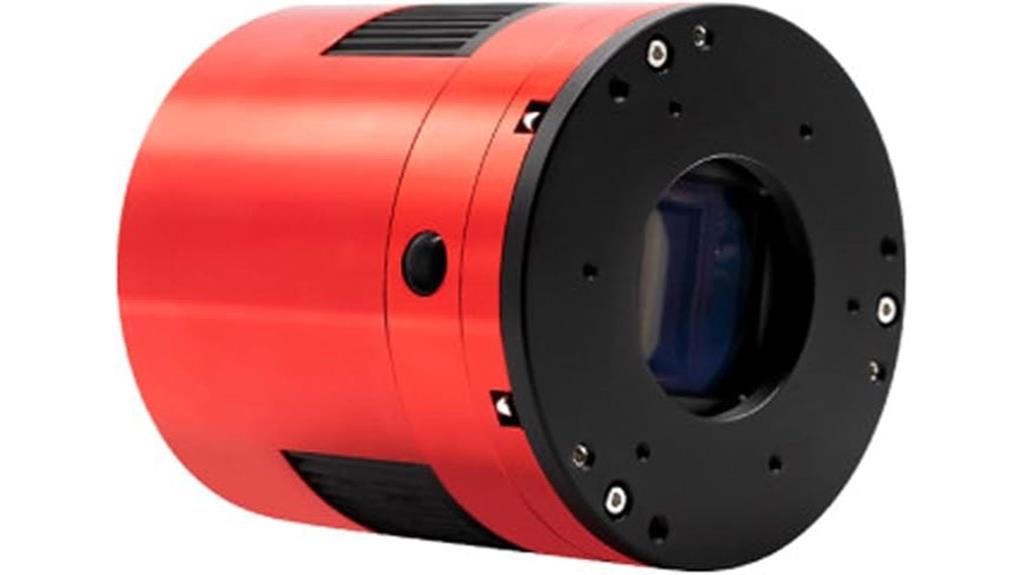
If you’re serious about capturing high-resolution deep-sky images, the ZWO ASI2600MM-Pro Monochrome Astronomy Camera is an excellent choice, especially for those who want detailed, low-noise results. Its 26-megapixel APS-C CMOS sensor delivers sharp images of nebulae, galaxies, and star clusters, with high quantum efficiency to maximize detail. TEC cooling keeps the sensor temperature 35°C below ambient, reducing noise during long exposures. The camera’s durable aluminum body and T-threaded adapters make it easy to connect to telescopes. Supported by USB 3.0 for fast data transfer, it’s perfect for astrophotographers aiming for professional-quality monochrome imaging.
Best For: astrophotographers seeking high-resolution, low-noise monochrome imaging of deep-sky objects with professional-level detail and ease of use.
Pros:
- High 26-megapixel APS-C CMOS sensor delivers sharp, detailed images of nebulae, galaxies, and star clusters.
- TEC cooling reduces sensor temperature by 35°C below ambient, minimizing noise during long exposures.
- Durable aluminum body and T-threaded adapters facilitate easy and reliable telescope connections.
Cons:
- Requires a separate 12V@3A power supply, which is not included.
- Lacks built-in color filters; uses external narrowband or color filters for imaging.
- Not designed for eyepiece viewing, limiting use to astrophotography setups.
SVBONY SV405CC Cooled Camera for Astrophotography
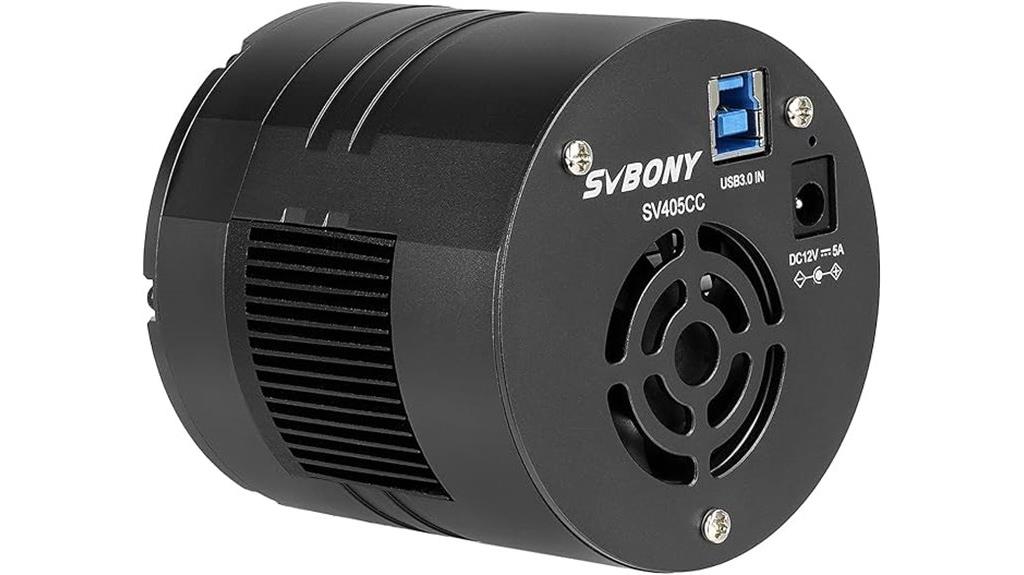
The SVBONY SV405CC Cooled Camera stands out for astrophotographers seeking high-resolution deep-sky imaging with minimal noise. Equipped with an IMX294 CMOS sensor, it delivers stunning images of nebulae, galaxies, and star clusters at 11.7 MP resolution and true 4K output at 120 fps. Its two-stage TEC cooling system reduces sensor temperature by 86°F below ambient, considerably lowering dark current during long exposures. With USB 3.0 connectivity and broad OS compatibility, including Windows, Linux, Mac, Chrome OS, and Raspberry Pi, it’s versatile and easy to integrate into various setups. This camera is a powerful tool for capturing detailed, vibrant deep-sky images.
Best For: astrophotographers seeking high-resolution, low-noise imaging of deep sky objects with versatile compatibility across multiple operating systems.
Pros:
- High-resolution 11.7 MP CMOS sensor with true 4K output at 120 fps for detailed imaging
- Effective two-stage TEC cooling system reduces sensor temperature by 86°F below ambient, minimizing noise during long exposures
- Broad OS compatibility including Windows, Linux, Mac OS, Chrome OS, and Raspberry Pi, with USB 3.0 high-speed data transfer
Cons:
- May require additional accessories or software setup for optimal use on certain operating systems
- Limited to astrophotography applications; not suitable for planetary or terrestrial imaging without modifications
- Cooling system adds complexity and potential maintenance considerations
ZWO ASI174MM-MINI Monochrome Astronomy Camera

Designed primarily for autoguiding and planetary imaging, the ZWO ASI174MM-Mini stands out with its compact size and sensitive monochrome CMOS sensor. It features a 2.3-megapixel sensor with 1936×1216 resolution and 5.86-micron pixels, delivering high quantum efficiency and low noise for detecting faint guide stars. Its lightweight, rugged red anodized aluminum body fits easily into a 1.25-inch focuser, making it compatible with standard telescopes. With USB 2.0 transfer at up to 18.4 fps and an ST4 port for direct guiding, it’s reliable and efficient. Many users praise its performance on long focal length systems and planetary imaging.
Best For: astrophotographers and astronomers seeking a compact, high-sensitivity guide and planetary imaging camera compatible with standard telescopes and focusers.
Pros:
- High quantum efficiency and low noise enable detection of faint guide stars and detailed planetary images.
- Compact, lightweight design fits easily into 1.25-inch focusers, ideal for space-constrained setups.
- Fast data transfer with USB 2.0 at up to 18.4 fps ensures smooth imaging and guiding performance.
Cons:
- Monochrome sensor requires additional filters for color imaging.
- Limited to USB 2.0, which may be slower compared to newer interfaces like USB 3.0 or 3.1.
- Primarily designed for guiding and planetary imaging; less suited for deep-sky astrophotography without additional equipment.
ZWO ASI183MC Pro 20.18 MP CMOS Color Astronomy Camera

For astrophotographers seeking high-resolution, color imaging with minimal noise, the ZWO ASI183MC Pro stands out thanks to its 20.18-megapixel CMOS sensor and advanced TEC cooling. Its large 13.2×8.8mm sensor offers 5496×3672 resolution with 2.4-micron pixels, capturing intricate details of deep-sky objects, the Moon, and the Sun. TEC cooling reduces sensor temperature by 40-45°C below ambient, drastically lowering noise during long exposures. The camera’s USB 3.0 interface ensures fast data transfer, and its compact, lightweight design makes it versatile for various setups. Overall, the ASI183MC Pro combines high resolution, sensitivity, and cooling efficiency for stellar astrophotography.
Best For: astrophotographers seeking high-resolution, low-noise color imaging of deep-sky objects, lunar, and solar scenes with advanced cooling capabilities.
Pros:
- High 20.18 MP resolution with detailed color images
- Effective TEC cooling reduces noise during long exposures
- Compact, lightweight design compatible with various telescopes and focusers
Cons:
- Requires a separate 12V power supply for TEC cooling
- Calibration with dark frames needed to manage amp glow noise
- Older model compared to newer ZWO cameras with potential for improved features
ZWO ASI120MM-Mini Monochrome Astronomy Camera

If you’re seeking a compact, reliable guiding camera that delivers sharp planetary images, the ZWO ASI120MM-Mini Monochrome Astronomy Camera stands out. Its small size—just 36mm in diameter and weighing only 2.1 ounces—fits easily into 1.25” focusers. With a 1/3” CMOS sensor, 1280×960 resolution, and 3.75-micron pixels, it offers high sensitivity and low read noise. The camera’s peak quantum efficiency of 75% guarantees accurate guiding and detailed planetary imaging, even in light-polluted conditions. Its USB-C connection and built-in ST4 port make setup straightforward, making it a must-have for guiding and planetary imaging in tight spaces.
Best For: amateur astronomers and astrophotographers seeking a compact, reliable guiding camera for planetary imaging, autoguiding, and working in tight or light-polluted environments.
Pros:
- High sensitivity with 75% peak quantum efficiency and low read noise for accurate guiding and detailed planetary images
- Compact size (36mm diameter, 2.1 ounces) fits easily into 1.25” focusers and small guidescopes
- Seamless compatibility with popular guiding software like PHD2 and the ZWO ecosystem, including ASIAIR Plus
Cons:
- Included USB-C cable may be too short for some setups, requiring an extension or replacement
- Slightly higher price point compared to similar guiding cameras, but justified by quality and reliability
- Limited to monochrome imaging; additional filters needed for color imaging
ZWO ASI183MC 20.18 MP CMOS Color Astronomy Camera with USB 3.0# ASI183MC
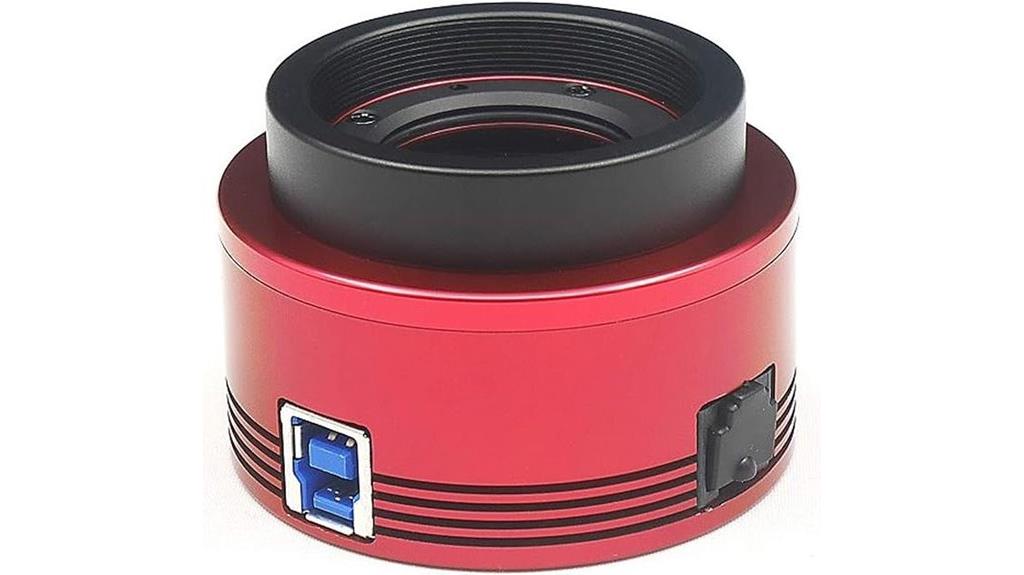
The ZWO ASI183MC stands out as an excellent choice for astrophotographers seeking high-resolution color imaging, thanks to its 20.1-megapixel CMOS sensor that captures fine details of deep-sky objects, the Moon, and the Sun. Its large sensor size (13.2mm x 8.8mm) guarantees sharp images while minimizing noise and exposure times. The camera supports USB 3.0 for fast data transfer, delivering up to 19 frames per second at full resolution. Compact and durable with a CNC aluminum body, it’s compatible with Mac and Windows systems. Ideal for planetary, lunar, and deep-sky imaging, it’s perfect for those wanting vibrant, detailed astrophotos without filters.
Best For: astrophotographers seeking high-resolution, vibrant color images of deep-sky objects, the Moon, and the Sun with fast data transfer and versatile compatibility.
Pros:
- High-resolution 20.1-megapixel CMOS sensor captures fine astrophysical details.
- Supports USB 3.0 for rapid data transfer at up to 19 fps at full resolution.
- Compact, lightweight, and durable CNC aluminum design compatible with Mac and Windows systems.
Cons:
- Non-cooled version may limit long-exposure imaging in very warm environments.
- Primarily designed for astrophotography, not suitable for eyepiece viewing.
- Additional accessories may be required for optimal imaging results, such as focal reducers or autoguiders.
SVBONY SV605CC Cooled Camera, 9MP CMOS for Astronomy
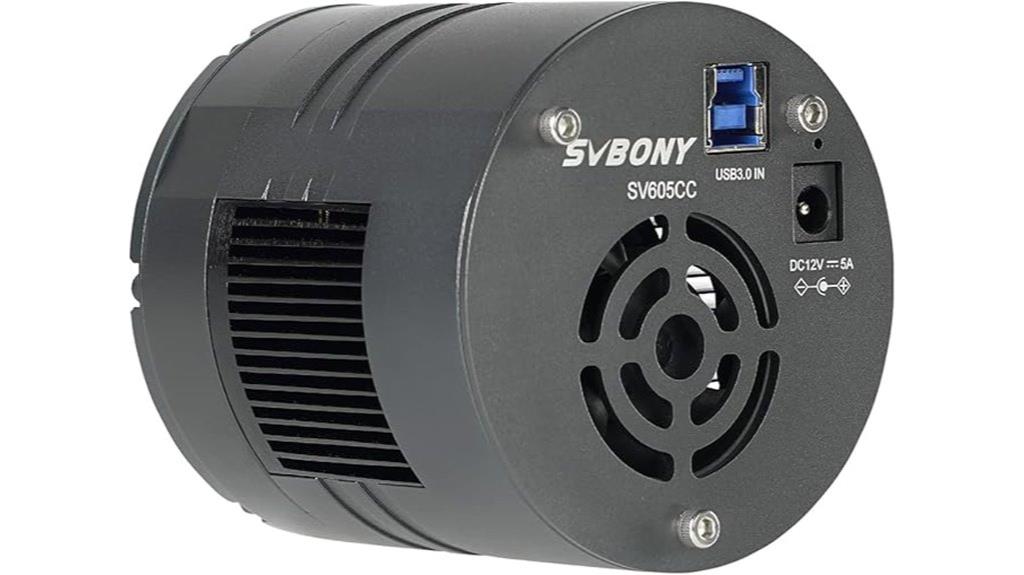
Positioned as an excellent choice for deep-sky astrophotography enthusiasts, the SVBONY SV605CC cooled camera leverages an advanced 9MP CMOS sensor to capture stunning detail. Its IMX533 1-inch square chip offers 3008×3008 resolution and 80% quantum efficiency, maximizing light capture. The camera’s glow suppression technology guarantees clearer images by reducing residual glow, while its TEC cooling system can lower sensor temperature by 30°C below ambient, minimizing noise during long exposures. Compatible with Windows, Linux, Mac OS, Chrome OS, and Raspberry Pi, it’s versatile for indoor or outdoor use, making it a solid option for capturing intricate celestial details.
Best For: amateur and professional astronomers seeking high-resolution, cooled astrophotography imaging capabilities for deep sky observation indoors and outdoors.
Pros:
- High 9MP resolution with 3008×3008 pixels for detailed celestial imaging
- Effective glow suppression technology enhances image clarity by reducing residual glow
- TEC cooling system lowers sensor temperature by up to 30°C to minimize noise during long exposures
Cons:
- May require additional accessories or adapters for specific telescope setups
- Slightly higher price point compared to non-cooled or lower-resolution cameras
- Learning curve involved in optimizing cooling and image processing for best results
ZWO ASI294MC 11.7 MP CMOS Color Astronomy Camera with USB 3.0# ASI294MC
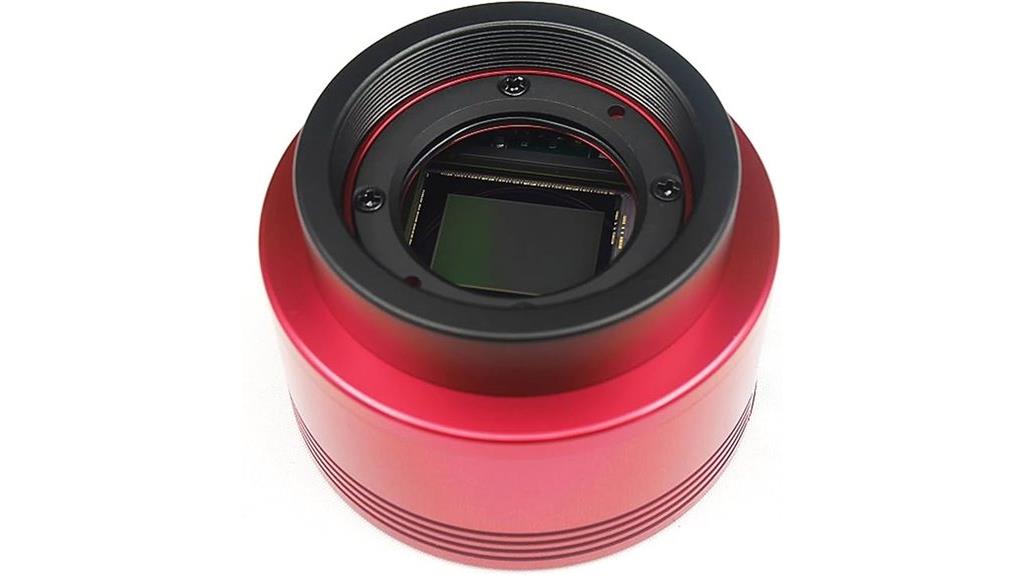
For astrophotographers seeking high-resolution color imaging, the ZWO ASI294MC stands out thanks to its advanced micro-4/3 CMOS sensor, which offers an impressive 11.7-megapixel resolution. This sensor captures fine details in nebulae, galaxies, and star clusters, making it ideal for deep-sky photography. The camera supports fast USB 3.0 transfer, enabling up to 16 frames per second at full resolution, ensuring smooth imaging sessions. Its compact, durable CNC aluminum body is perfect for field use, and it’s compatible with both Mac and Windows systems. Overall, the ASI294MC provides a powerful, versatile tool for serious astrophotographers.
Best For: serious astrophotographers seeking high-resolution, detailed imaging of deep-sky objects and planetary features with fast data transfer and reliable performance.
Pros:
- High-resolution 11.7 MP CMOS sensor captures fine astronomical details.
- Supports fast USB 3.0 transfer at up to 16 fps for smooth imaging sessions.
- Durable, compact CNC aluminum body ideal for field use and portability.
Cons:
- Requires compatible software and drivers, which may need installation.
- No included solar filter for solar imaging, necessitating additional accessories.
- T-threaded nosepiece and 2″ adapter are sold separately, adding to setup costs.
Celestron NexImage 20 Solar System Camera

If you’re looking for a dedicated planetary camera that combines high resolution with ease of use, the Celestron NexImage 20 stands out as an excellent choice. It features a 20 MP back-illuminated CMOS sensor, delivering sharp, detailed images of the Moon, planets, and Sun (with filter). Its 1.25-inch nosepiece ensures compatibility with standard focusers, and USB-C offers quick data transfer. The camera’s ROI feature allows cropping for higher frame rates, while included software lets you control gain, exposure, and more. With built-in autoguiding support and a 2-year warranty, it’s a versatile tool perfect for both beginners and experienced planetary imagers.
Best For: planetary and Solar System astrophotographers seeking high-resolution, easy-to-use imaging with versatile features suitable for both beginners and advanced users.
Pros:
- High-resolution 20 MP CMOS sensor captures detailed lunar, planetary, and solar images
- USB-C interface ensures fast, reliable data transfer and quick setup
- Built-in autoguiding capability supports precise tracking for long-exposure imaging
Cons:
- Limited to Solar System objects; not designed for deep-sky astrophotography
- Requires compatible focusers and adapters for optimal use, which may add to setup complexity
- Software may have a learning curve for complete beginners unfamiliar with astrophotography controls
Celestron NexImage 5 Solar System Imager (MT9P031)
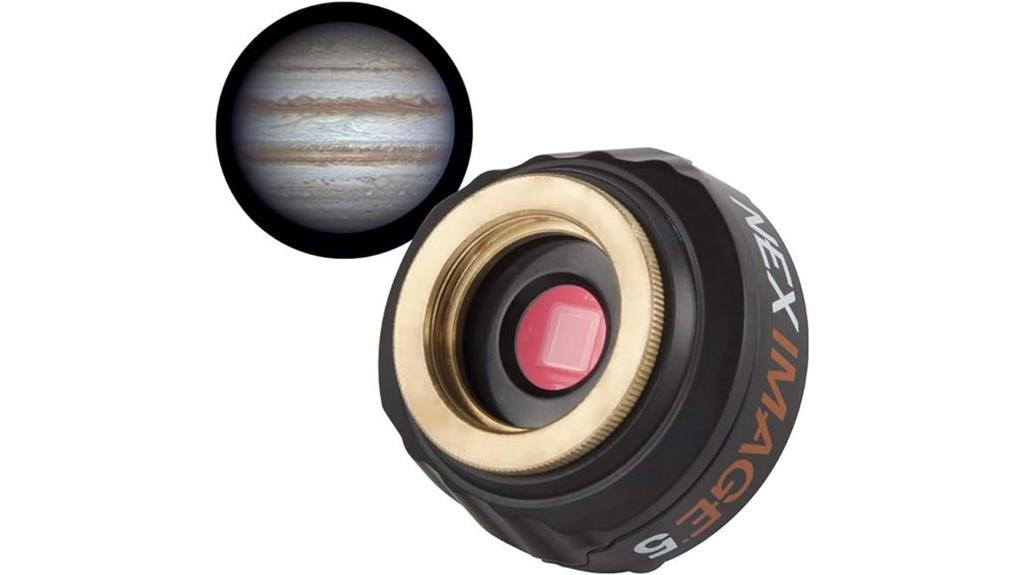
The Celestron NexImage 5 Solar System Imager (MT9P031) stands out as an excellent choice for beginners looking to dip into planetary and lunar imaging. Its 5 MP CMOS sensor captures sharp, detailed color images with reduced noise, perfect for observing the Moon and planets. The camera offers flexible features like region of interest sub-framing, binning options, and progressive scan. It’s easy to set up with a simple USB 2.0 connection, requiring no external power, and fits standard 1.25-inch focusers. With included software for live viewing, recording, and stacking, it makes astrophotography accessible and enjoyable for newcomers. Plus, Celestron’s 2-year warranty adds peace of mind.
Best For: beginners and amateur astronomers seeking an easy-to-use, affordable planetary and lunar imaging solution with high-resolution color imaging.
Pros:
- User-friendly plug-and-play USB 2.0 connection requiring no external power
- High-resolution 5 MP CMOS sensor captures detailed, low-noise images of the Moon and planets
- Flexible imaging options like region of interest, binning, and progressive scan for customized results
Cons:
- Limited to standard 1.25-inch focusers; may not fit larger or specialized telescopes easily
- Primarily designed for planetary and lunar imaging; less suitable for deep-sky astrophotography
- Software features are basic compared to more advanced astrophotography systems
SVBONY SC432M Monochrome Cooled Planetary Camera
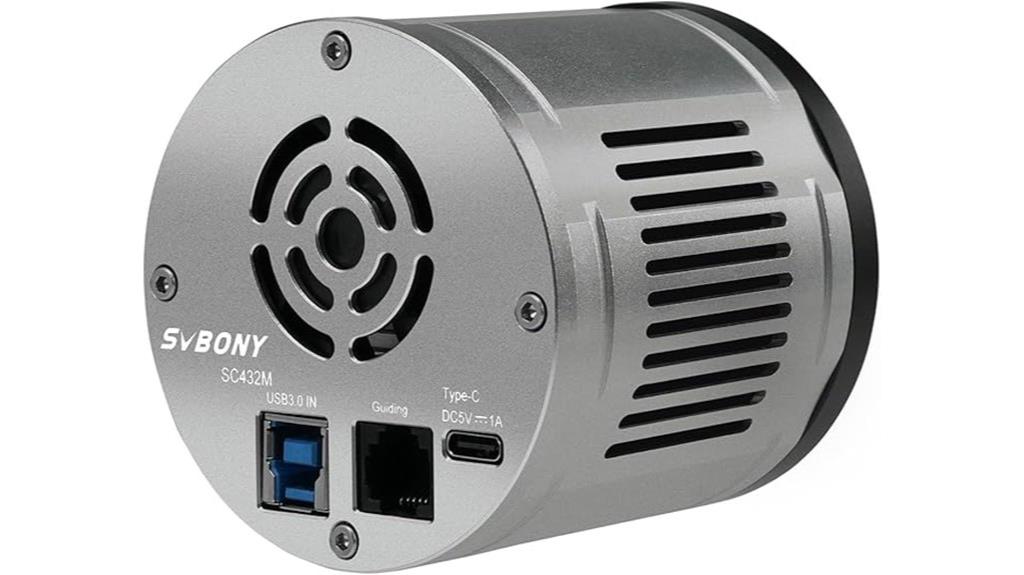
Equipped with a 1.77MP IMX432 CMOS sensor and global shutter, the SVBONY SC432M Monochrome Cooled Planetary Camera delivers exceptional imaging performance for lunar and planetary astrophotography. Its large 9μm pixels offer high sensitivity, capturing fine details and subtle color variations. The 1.1-inch sensor provides a broad field of view, reducing the need for extensive post-processing. Cooling via fan lowers temperatures by 5-10°C, minimizing noise during long exposures. With USB 3.0 support for fast data transfer and a high frame rate of up to 120 fps, it’s ideal for high-speed imaging of fast-moving objects like the ISS. It’s a versatile, reliable choice for planetary imaging.
Best For: amateur and professional astronomers seeking high-sensitivity, high-speed planetary imaging with minimal noise and a broad field of view.
Pros:
- High sensitivity with large 9μm pixels for capturing fine lunar and planetary details
- Fast data transfer with USB 3.0 support, supporting up to 120 fps for high-speed imaging
- Effective cooling system reduces noise during long exposures, improving image quality
Cons:
- Monochrome sensor requires separate filters for color imaging, adding complexity
- Relatively bulky dimensions (6.1 x 5.16 x 6.1 inches) may limit portability
- Limited to monochrome imaging without built-in color capabilities, potentially requiring additional equipment
ZWO ASI174MM 2.3 MP CMOS Monochrome Astronomy Camera with USB 3.0# ASI174MM
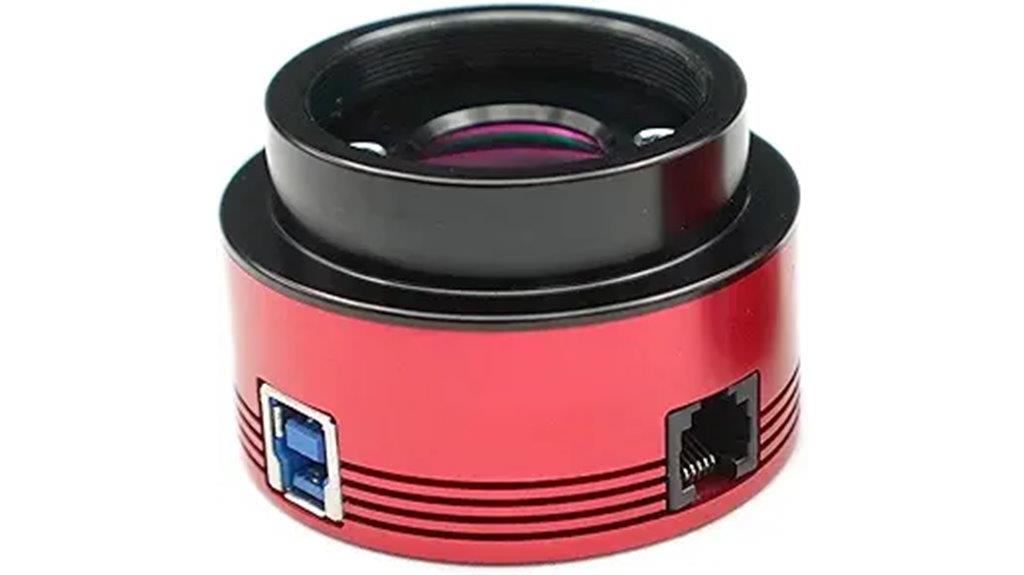
For astrophotographers seeking high-resolution monochrome imaging, the ZWO ASI174MM stands out with its advanced 2.35-megapixel CMOS sensor and fast USB 3.0 transfer speeds. It captures fine details of planets, the Moon, Sun (with a safe solar filter), and deep-sky objects, thanks to its 1936×1216 resolution and 5.86-micron pixels. The camera supports rapid data transfer—up to 164 frames per second at full resolution—making it ideal for capturing dynamic celestial events. Its compact, durable design with a T-threaded nosepiece ensures compatibility with most telescopes. Plus, it’s compatible with both Mac and Windows, backed by reliable software, making it a versatile choice for serious astrophotographers.
Best For: astrophotographers seeking high-resolution monochrome imaging of planets, the Moon, Sun (with solar filter), and deep-sky objects using a compact, durable camera compatible with most telescopes.
Pros:
- High sensitivity with 2.35-megapixel CMOS sensor and 5.86-micron pixels for detailed celestial images
- Fast USB 3.0 transfer speeds supporting up to 164 frames per second at full resolution
- Compact, lightweight, and rugged design ensures portability and durability for field use
Cons:
- Monochrome imaging requires additional LRGB filters and processing for full-color images
- Not designed for direct eyepiece photography; intended for imaging through telescopes only
- May require a powerful computer and learning curve for optimal setup and image processing
SVBONY SV205 Astrophotography Camera (7.05MP, CMOS, USB3.0)
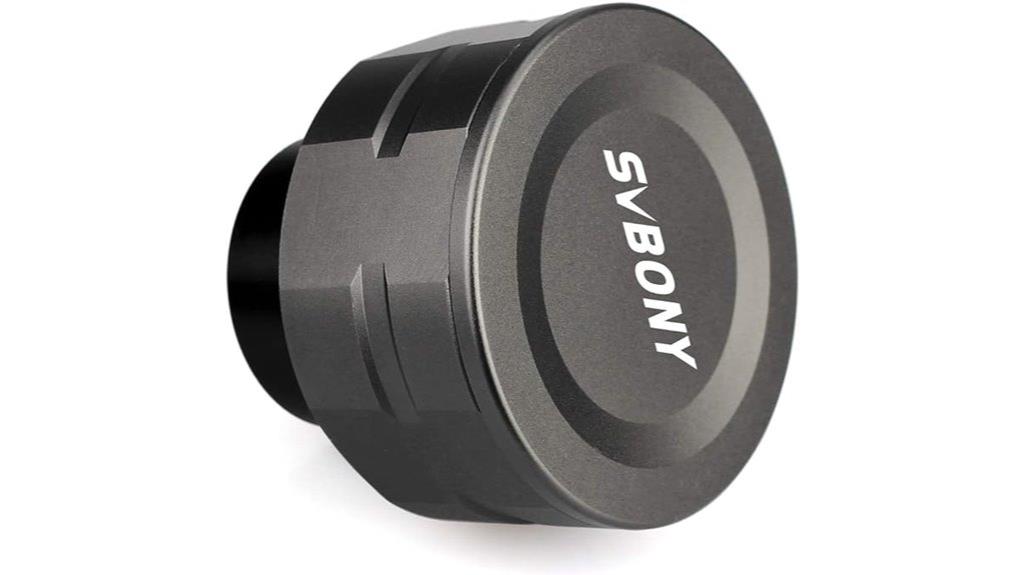
If you’re just starting out in astrophotography and want a reliable, budget-friendly camera, the SVBONY SV205 stands out with its 7.05MP CMOS sensor and USB 3.0 connectivity. It’s designed for beginners, offering easy setup and compatibility with Windows and Mac. The camera excels at planetary and lunar imaging, capturing planets like Mars and Saturn with clarity. It supports real-time observation and video recording up to 4K at 15FPS. While some users report color balance issues and stability challenges, overall, it’s a solid choice for hobbyists seeking an affordable, straightforward device to explore planetary imaging and terrestrial observation.
Best For: beginner and hobbyist astrophotographers looking for an affordable, easy-to-use camera primarily for planetary and lunar imaging.
Pros:
- Easy plug-and-play setup compatible with Windows and Mac
- High-resolution 7.05MP CMOS sensor for clear planetary images
- Supports real-time observation and 4K video recording at 15FPS
Cons:
- Short barrel length can make securing in some eyepiece holders difficult
- Color balance issues such as magenta and blue hues may require adjustments
- Stability can be affected by stiff USB cables and vibration during imaging
ZWO ASI183MM Pro 20.18 MP CMOS Monochrome Astronomy Camera
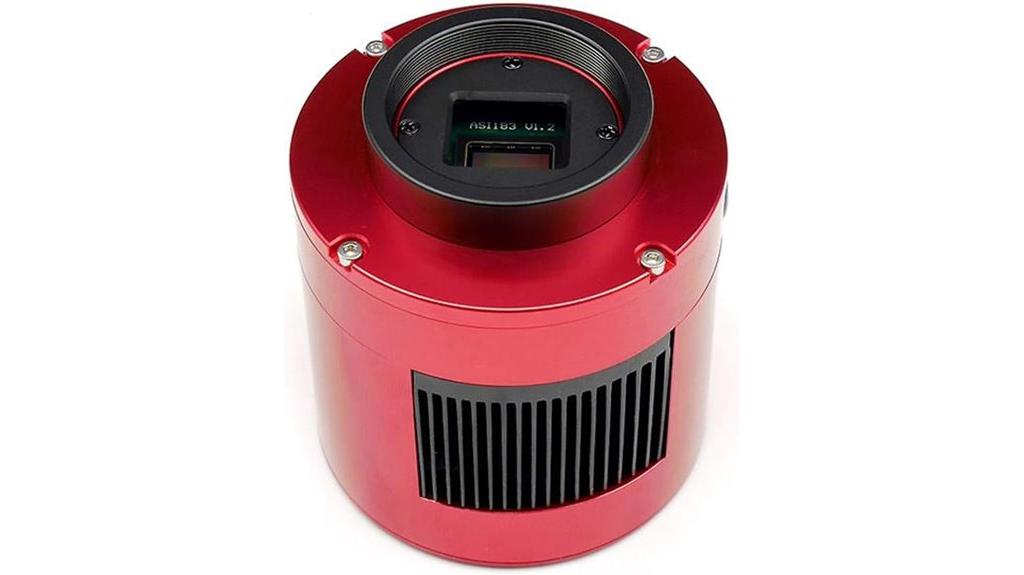
The ZWO ASI183MM Pro stands out as an excellent choice for astrophotographers seeking high-resolution monochrome imaging, thanks to its 20.18 MP CMOS sensor with 2.4-micron pixels. It captures intricate details of deep-sky objects like nebulae, galaxies, and the Moon, while its high quantum efficiency shortens exposure times. The integrated TEC cooling reduces sensor temperature by up to 45°C below ambient, minimizing noise. With fast USB 3.0 transfer at 19 fps, a large buffer, and compatibility with Mac and Windows, it offers reliable, low-noise imaging. Its durable CNC aluminum body and versatile mounting options make it ideal for both amateur and professional astrophotographers.
Best For: amateur and professional astrophotographers seeking high-resolution, low-noise monochrome imaging of deep-sky objects, the Moon, and planets.
Pros:
- High-resolution 20.18 MP CMOS sensor with 2.4-micron pixels for detailed imaging
- Effective TEC cooling reduces sensor temperature by up to 45°C below ambient, minimizing noise
- Fast USB 3.0 data transfer at 19 fps with a large buffer for stable imaging sessions
Cons:
- Requires a separate 12V power supply for TEC cooling, adding to setup complexity
- No included solar filter for solar imaging, necessitating additional accessories
- Compatibility limited to Mac and Windows, which may exclude other operating systems
SVBONY SV605MC Telescope Camera, 9 Megapixel, IMX533 Sensor, CMOS Cooled Monochrome Astronomy Camera
Are you looking for an affordable yet capable astrophotography camera that can handle deep sky imaging with precision? The SVBONY SV605MC fits that bill. It features a Sony IMX533 sensor with 9 Megapixels and a 14-bit A/D converter, delivering sharp, detailed images. Its two-stage TEC cooling reduces sensor temperature by up to 30°C, minimizing noise during long exposures. Designed for deep sky, planetary, and meteor imaging, it supports narrow-band filters and lucky imaging. While setup can be tricky, especially with driver installation, it offers high-speed readout at 20 FPS and low readout noise, making it a solid option for budget-conscious astrophotographers willing to troubleshoot.
Best For: budget-conscious amateur astrophotographers willing to troubleshoot setup issues and manage potential image quality variability.
Pros:
- High-resolution 9 Megapixel Sony IMX533 sensor delivers detailed images.
- Effective two-stage TEC cooling reduces sensor temperature by up to 30°C, minimizing noise during long exposures.
- Supports narrow-band filters and lucky imaging, making it versatile for various astrophotography applications.
Cons:
- Customer reviews indicate issues with banding, hot pixels, and amp glow affecting image quality.
- Setup can be complicated, especially driver installation and ensuring proper USB connection.
- Some units may require repairs outside warranty, and manufacturing variability can impact reliability.
Factors to Consider When Choosing Aps C Cmos Astro Camera

When selecting an APS-C CMOS astro camera, I consider several key factors to guarantee I get the best results. I look at sensor resolution, cooling features, and connectivity options to suit my needs. Durability and performance aspects also play a vital role in making the right choice.
Sensor Resolution Quality
Choosing the right sensor resolution for an APS-C CMOS astro camera is essential because it directly affects the level of detail you can capture in your images. Higher resolution sensors, measured in megapixels, enable me to resolve finer details in deep-sky objects, planets, and lunar features. Cameras with 1.5 MP to over 20 MP offer different advantages; more megapixels mean sharper, more detailed images, but also larger data files that require more storage and processing time. Balancing resolution with pixel size is vital—larger pixels at lower resolution can boost sensitivity and reduce noise, especially in low-light conditions. Additionally, the sensor resolution impacts the camera’s field of view, influencing framing and composition when paired with various telescopes.
Cooling Capabilities Features
Cooling capabilities in CMOS astro cameras play a crucial role in capturing clear, high-quality images during long exposures. They help reduce sensor temperature, which minimizes thermal noise and dark current that can blur astrophotographs. Two-stage TEC cooling systems can lower sensor temperatures by up to 40-45°C below ambient, markedly improving image quality in low-light conditions. Effective cooling allows for longer exposure times without increasing noise, essential for deep-sky imaging of faint objects. However, these cooling systems often require extra power sources and can add size and weight to the camera. Advanced cooling features ensure greater stability and consistency in astrophotography results, especially during extended sessions. Overall, good cooling capabilities are essential for achieving crisp, detailed images in challenging lighting conditions.
Connectivity and Compatibility
Ensuring your astro camera connects seamlessly to your setup is vital for smooth imaging sessions. I look for cameras that support fast data transfer interfaces like USB 3.0, which guarantees stable and rapid image streaming. Compatibility with my operating system—whether Windows, Mac OS, or Linux—is essential to avoid software issues. I also verify that the camera can connect to standard telescope accessories, such as 1.25-inch or 2-inch focusers, for versatile mounting options. Additionally, I check if it’s compatible with my guiding and imaging software, like ASCOM or PHD2, to streamline control and automation. Finally, I prioritize manufacturers that provide reliable drivers and regular software updates, ensuring continued compatibility with evolving systems and imaging tools over time.
Frame Rate Performance
A high frame rate is vital for capturing fast-moving celestial objects and achieving sharp, detailed images during planetary and lucky imaging sessions. The maximum frame rate at full resolution varies among APS-C CMOS cameras, typically from 3 to 20 frames per second, affecting real-time viewing and focusing. Lowering the resolution or using a region of interest (ROI) can greatly boost frame rates, making it easier to capture quick sequences. To sustain high frame rates, a robust data transfer interface like USB 3.0 or higher is indispensable to prevent bottlenecks. Balancing frame rate with image quality involves considering sensor readout speed, processing power, and storage capabilities. Ultimately, optimizing these factors ensures you get the most out of your astro camera during fast imaging sessions.
Build Quality Durability
Choosing a robust build quality is essential because it directly influences how well your astro camera withstands the rigors of fieldwork. A sturdy construction made from CNC aluminum or high-strength alloys resists deformation and corrosion, ensuring longevity. Proper sealing with weatherproofing or waterproofing protects against dust and moisture, crucial for outdoor use. Heavier, well-made cameras tend to offer better shock resistance and minimize vibrations, which are critical for sharp astrophotography. Additionally, quality manufacturing processes like precision machining and thorough assembly ensure consistent alignment and reliable long-term performance. These factors not only protect your investment but also contribute to stable, high-quality imaging over time. Ultimately, a durable build allows you to focus on capturing stellar images without worrying about equipment failure.
Software Integration Ease
Seamless software integration is vital because it streamlines your workflow and minimizes setup headaches. I look for cameras that support popular astrophotography software like SharpCap, NINA, or ASIAIR, ensuring compatibility and ease of use. It’s also indispensable that the camera works smoothly with my operating system—whether Windows, Mac OS, or Linux—to avoid driver conflicts. I check if the manufacturer provides official drivers and regular software updates, which keep the camera compatible with evolving software ecosystems. An accessible SDK or API is a bonus, allowing for custom automation or advanced workflows. Ultimately, plug-and-play connectivity really speeds up setup, whereas requiring extra configuration can be a hassle. Overall, straightforward software integration saves me time and frustration during my imaging sessions.
Price and Budget Fit
Your budget plays a vital role in selecting the right APS-C CMOS astro camera, so I always start by clearly defining what I can afford. Comparing your budget to camera prices helps guarantee your choice fits financially. It’s crucial to evaluate if the camera’s features justify its cost, especially considering your astrophotography goals and experience level. Remember to factor in additional expenses like accessories, filters, and software, which can add up. Higher-priced models often provide advanced sensors, better cooling, and faster data transfer, offering better long-term value. Equally important is considering the camera’s reliability, warranty, and customer support to maximize your investment’s longevity. Finding the right balance between cost and features ensures you get a camera that meets your needs without overextending your budget.
Size and Mount Compatibility
Since the physical compatibility between your camera and telescope is essential for secure and effective imaging, I always check sensor size and mounting threads first. Matching the camera’s sensor size and mount thread, like T-thread or M42, guarantees a secure fit with your focuser or adapter. It’s also important to verify that the camera’s dimensions and weight align with your mount’s load capacity to maintain stability. Compatibility with existing focusers or adapters streamlines setup and reduces frustration. Additionally, consider how the sensor size affects your target objects; larger sensors give wider fields of view, ideal for deep-sky imaging, while smaller sensors are better for high-magnification planetary shots. Proper size and mount compatibility help optimize your imaging experience and results.
Frequently Asked Questions
How Does Sensor Size Impact Astrophotography Image Quality?
Sensor size greatly impacts astrophotography image quality because larger sensors capture more light, resulting in brighter, clearer images with less noise. With a bigger sensor, I notice better detail and improved performance in low-light conditions, which is vital for capturing faint stars and deep-sky objects. Smaller sensors tend to produce images with more noise and less detail, making larger sensors my preferred choice for stunning astrophotos.
What Are the Best Cooling Methods for CMOS Astro Cameras?
I find that active cooling methods like thermoelectric (TE) cooling are the best for CMOS astro cameras. They efficiently reduce sensor temperature, minimizing noise during long exposures. I also recommend using proper heat sinks and fans to dissipate heat effectively. Keeping the camera in a cool, stable environment helps maintain image quality. Overall, good cooling guarantees clearer, sharper astrophotos by controlling thermal noise.
How Important Is Frame Rate for Deep-Sky Imaging?
Frame rate might seem less critical in deep-sky imaging, but it actually plays a essential role. I’ve found that a higher frame rate allows me to capture more frames quickly, reducing noise and improving image quality through stacking. It also helps in tracking fast-moving objects or atmospheric disturbances. So, while not the only factor, a good frame rate enhances your ability to produce clearer, more detailed astrophotos.
Can These Cameras Be Used With Different Telescope Types?
Yes, these cameras can be used with different telescope types. I’ve found they’re quite versatile, fitting well with refractors, reflectors, and catadioptrics. Just make sure you have the right adapters and mountings. I recommend checking the camera’s compatibility specs before purchasing. Once set up, you’ll enjoy capturing stunning deep-sky images regardless of your telescope type, making these cameras a flexible choice for any astrophotographer.
What Software Compatibility Issues Should I Consider?
When choosing software for astrophotography, I always check compatibility with my camera’s firmware and operating system. Sometimes, drivers or updates can cause issues, so I look for cameras with strong software support and regular updates. I also consider whether the software integrates well with my telescope control and image processing tools. Ensuring seamless connectivity reduces frustration and helps me focus on capturing stunning stellar images.
Conclusion
Choosing the right APS-C CMOS astro camera is like finding the perfect telescope lens—you want clarity, sensitivity, and reliability. I remember my first deep-sky shot, blurry yet breathtaking, sparking my passion. Just like that moment, picking the right camera can turn starry nights into stunning images. Trust me, with the right gear, your astrophotography journey will be as rewarding as reaching for the stars itself.

